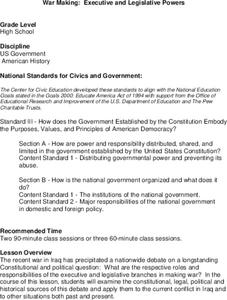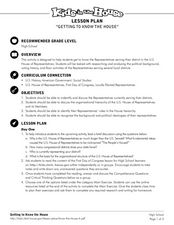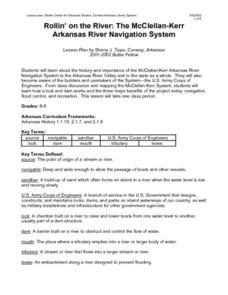Curated OER
War Making: Executive and Legislative Powers
Students examine Constitution and what it says about war-making power, contrast roles and responsibilities of executive and legislative branches of government when it comes to making war, become familiar with important 20th and 21st...
Curated OER
Understanding by Design
Fourth graders examine the origins, structures, and functions of the Colorado government. In this understanding by design lesson, 4th graders explore the three branches of government. Students identify the roles of state leaders and the...
Curated OER
I'm Just a Bill
Fourth graders study the three branches of government and the process of how a bill becomes a law. They watch the School House Rock video "I'm Just a Bill" and sing the song after viewing the video. They answer question regarding a bill...
Curated OER
Civics Review for Grade 3
In this civics review for grade 3 worksheet, 3rd graders answer 25 multiple choice questions about U.S. government in standardized test format.
Curated OER
Supreme Court Decisions and Their Effect On Us
Consider five Supreme Court cases and how their outcomes have directly affected the American population. Government students research and compose a 1-2 page pager outlining the examples of our daily life that have specifically been...
Curated OER
Government for the People
Seventh graders read about the three branches, the balance of power an the system of checks and balances. They analyze current events in terms of which vranch of government is responsible for addressing issues. Students create a poster...
Curated OER
Government
Eighth graders analyze the purposes of government. They examine or assess the importance of citizenship to the individual or to society at large (e.g., the importance of voting). Students explain the structure and functions of the three...
Curated OER
Branches of Government Graphic
Students explore the three branches of government. They create a graphic diagram to show each branch of government. Students include the qualifications for service and duties of each branch of government in their graphic diagram.
Curated OER
James Madison: From Father of the Constitution to President
Students investigate reasons why James Madison is called the "Father of the Constitution." They discuss three events during his presidency that raised constitutional questions and look at Madison's opinions of those questions. They...
Curated OER
US Government: Supreme Court
Students explore the powers of the Supreme Court. In this Judicial Branch lesson, students define vocabulary regarding the branch's responsibilities, take notes on a video regarding the branch, and discuss the powers of the branch in a...
Curated OER
Leaders in the Judicial Branch
Young scholars examine the leadership roles and qualities of members of the judicial branch in public life. They view and discuss video clips from a federal judge and two Supreme Court judges.
Curated OER
Checks and Balances Chart
In this checks and balances chart worksheet, students use their textbooks and a copy of the U.S. Constitution to complete 10 items in the chart identifying the branches of government.
Curated OER
Getting to Know the House
Students take a closer look at representative government. In this House of Representatives lesson, students discuss their local representative in Congress and research his or her responsibilities. Students respond to the provided...
Curated OER
Geography of the Hill
Middle schoolers explore the basic functions of Canadian government, who is responsible for each function and where the officials associated with each function work.
Curated OER
A Bill Becomes A Law
Students discover how a bill becomes a law. In this Legislative Branch lesson, students simulate a bill making its way through the House and the Senate. Students author their own bills in this simulation.
Curated OER
Our Country's People, Lesson Two
In this US government worksheet, students answer 8 multiple choice questions about the laws, courts, and Constitution of the United States.
Curated OER
Follow a Bill!
Students discover how a bill becomes a law. In this Legislative Branch lesson plan, students watch C-Span coverage of a bill making its way through the House and the Senate. Students use the provided worksheet to chart the progress of...
Curated OER
TE Activity: Pollution Politics
Students examine how a bill becomes a law in the US Congress. They investigate legislation about global warming. They determine the role of engineers as they educate Congress, the public and other government institutions about global...
Curated OER
Constitution Lesson Plan
Third graders identify roles of Declaration of Independence and U.S. Constitution in establishing new country, create posters with their ideas about each part of Constitution, and explain three branches of government, including their...
Curated OER
Voting Simulation
Students explore the process of voting. They study the lawmaking branch of the state government.
Curated OER
American History Through the Len of the Supreme Court Decisions
Students examine the historical background of Supreme Court decisions and the basic principles behind legislation. As part of the lesson, students discover legal concepts and terms and write sentences using the vocabulary they have...
Curated OER
The Civil War
Although we currently focus on Abraham Lincoln's positive contributions in creating a more equal society, the truth is that Lincoln was actually a controversial character in his time! After studying the Civil War, give your high...
Curated OER
Rollin' on the River: The McClellan-Kerr Arkansas River Navigation System
Middle schoolers take a close look at the McClellan-Kerr Arkansas River Navigation system. They study how the Army Corps of Engineers built and monitor the system. Learners discover how a lock and a dam work, and study three benefits of...
C-SPAN
Judicial Review and Marbury v Madison
The Supreme Court case Marbury v. Madison may not be widely recognized but the landmark case is particularly significant because it established the precedent for judicial review and that the Supreme Court had power as an interpreter of...

























